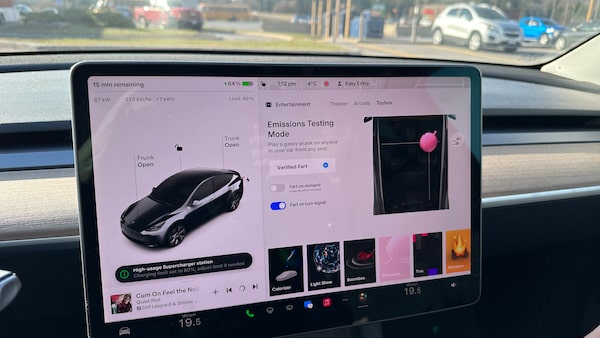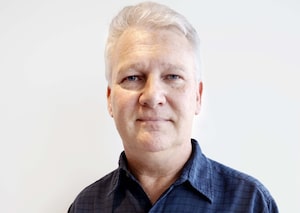
During a test of a Tesla Model Y, the author and owner of the test vehicle stopped at a Tesla Supercharger station where 250 kilometres of range cost $27.Mark Richardson/The Globe and Mail
This is not a normal car review because the Tesla Model Y is not a normal car. It is certainly not built by a normal car company. Tesla does not provide vehicles to journalists for review and it doesn’t even have a communications department. If I want to find out about a Tesla, I have to do so like everyone else and scour the company website and online forums. If I want to drive a Tesla for more than a 20-minute joy ride, I have to buy one or rent one or borrow one from a friend.
So I went for a drive with my friend George in his 2022 Model Y Performance, and he told me about his car.
George asked that I not publish his full name so he could speak freely, after the example of another friend who let me drive his Model S three years ago. Back then, I wrote about how his car’s Autopilot system malfunctioned and that friend was concerned about backlash from other Tesla owners, especially when I posted the video as proof. Tesla owners can be defensive of the brand, and I suspect he got a lot of criticism for lending me the car because he hasn’t spoken to me since.
George, however, was happy to take me for a drive and then let me take the wheel. A year ago, he traded in his Audi SQ5 for the Model Y after placing a deposit six months earlier. His wife Catherine already owned an Audi e-tron. George paid $82,900 for his Tesla, before freight, predelivery inspection and taxes. At the time, he thought he was getting a good deal because it had been listed as high as $99,000, but today, the same car sells new for $74,290.
He loves his Model Y and has driven it for 35,000 kilometres so far, but he has a problem with the volatile pricing. George is careful to buy only cars with high resale values because, by his own admission, he’s too fickle to usually keep a car longer than a couple of years.
“Tesla guys are like Apple people and they want the latest one out,” he told me. “Boy, is it rough if you’re a Tesla owner or an Audi owner and you need to get out of [owning] your EV, because you have so much negative equity in your vehicle right now. You are toast.”

The 15-inch screen on the Tesla Model Y, which is excellent when the car is parked.Mark Richardson/The Globe and Mail
Most people who finance their purchase of a new car will hold “negative equity” for several years, in which the car devalues so quickly that it is not worth the amount you still owe on it. Many financing terms are now for seven years, which is a lifetime for the average owner of an electric car. Would you own your smartphone, with its rapidly dating technology, for seven years?
The challenge is that the prices of new Teslas dropped so rapidly and unexpectedly in the past year. Also, the technology inside a Tesla is changing as fast as a cellphone. The new Model 3 Highland, for example, no longer has an indicator stalk nor any kind of physical shift lever, and has the lowest drag co-efficient of any Tesla, at 0.219, making it enviably aerodynamic. There’ll probably be a lot of one- and two-year-old Model 3s coming onto the market soon, so those owners can upgrade to the Highland, bringing used prices down even further. Used cars don’t qualify for the $5,000 federal rebate, of course, nor most provincial rebates.
The Model 3 and Model Y look almost identical on the road, but the Model 3 is the lowest-priced sedan and the Model Y is the taller SUV, which is much larger inside with up to 2,158 litres of cargo space.
Is it all worth it to own a Tesla? George pressed the throttle to the floor and smiled as he did so.
“That never gets old for me,” he said, as we surged forward.
Tesla claims a zero-to-100 kilometre an hour acceleration of 3.7 seconds for the Model Y Performance, though George said his car is not so quick when the battery is not fully charged. I didn’t time the acceleration with my smartphone app, but it certainly felt plenty quick. The regular rear-wheel-drive Model Y is much slower off the mark with an acceleration time of 6.9 seconds, but it’s more affordable, at $57,990. Its claimed range is 394 kilometres, while the long-range all-wheel-drive edition offers a range of 497 kilometres and acceleration of five seconds, for $67,990.
The Performance edition has a claimed range of 459 kilometres, which George said is optimistic. “I only charge to 90 per cent, but I drive it quickly, and I would say I’m probably closer to a 300-to-350-kilometre range on a full charge with normal driving at normal temperatures. I haven’t noticed a huge difference in winter. If you baby it, I’m sure you could get close to [the claimed range], but nobody drives like that.”

Like almost every command, it takes two taps through the menus of the central display screen to make it happen.

The 2022 Tesla Model Y Performance can be adjusted so the indicator makes farting noises.Mark Richardson/The Globe and Mail
George bought his Tesla because he sometimes drives long distances and needs to charge at least once a week at a public charging station; he was fed up with the challenges of using generic stations with his wife’s Audi e-tron, where the chargers might be broken, slow or unavailable. Instead, Tesla Superchargers are plentiful and when he plugs in his car, the charger exchanges information with the vehicle and his credit card is billed automatically. It’s a simple process.
It’s no longer an inexpensive process, however. We stopped at a Tesla Supercharger station and George spent $27 adding 250 kilometres of range, which took about 20 minutes at an average speed of 61 kilowatts. Compare that to the $65 he would have spent in premium gas for the same range in his Audi SQ5, or the $16 a Toyota Prius owner would spend. All are excessive, however, compared to the $2.50 he typically spends on a full overnight charge at home.
A couple of years ago, George said, he and Catherine were spending about $1,000 a month on gas, and now their two cars cost about $80 a month in electricity. Maintenance has been negligible. Catherine is not so deterred by public chargers for her Audi Q4 e-tron, despite driving similar distances. She typically uses Flo chargers, where she has an account and pays through the app on her phone.
“I definitely wouldn’t go back to a gas car,” she said. “For me, it comes down to the air we breathe, and the ease of driving. We’ve got to a place now where this is actually a sustainable option.”

The back seats of the 2022 Tesla Model Y Performance.Mark Richardson/The Globe and Mail
She prefers her Audi over George’s minimalist Tesla, however. “Mine resembles a car, while the Tesla feels more like a lounge room on wheels,” she said. “My position is that Tesla is a tech company that makes cars, but Audi is an actual car company that makes electric cars.”
And my impressions of the Model Y, for this unconventional review?
It’s very convenient – its key resembles a credit card and so it recognizes you, unlocking the door and preparing the motor and cabin without the need to even press a button. Other EV makers are now copying this. The drive itself was a little noisier than I expected, but a change to the glass in more recent models has quietened the ride. The gaps between some of the outside panels were a bit wonky, but nothing too upsetting.

The trunk of the 2022 Tesla Model Y Performance with the seats folded down.Mark Richardson/The Globe and Mail
The cabin is simplistic to an extreme, with all information on the central horizontal screen. This also displayed shadowy icons of surrounding traffic while I was out on the road, and a navigation map. I would have liked to have turned off the more distracting elements of that screen completely, so only the speed was displayed in the top left corner and perhaps a couple of other essential gauges, but there seemed no way to do so.
I would also have liked to have adjusted the strength of regenerative braking while driving, as most EVs offer, but the Model Y only provided this as an option in Track mode, and like almost every command, it took two taps through the menus of the central display screen to do so. Want to adjust the mirrors? Two taps. Open the glovebox? Two taps. Get the indicator to make farting noises? Two taps on the screen.
That 15-inch screen is a wonderful thing when the car is parked because it really does transform the vehicle into a living room. George told me of catching up on his favourite Netflix series while waiting for his son at sports practice: The car is kept warm without needing to idle, and the surround-sound is phenomenal.
So is George sold? Is he a Tesla fan?
“I’m not all in,” he said, when we finally returned home. “It’s just the pricing structure that really bothers me. Will I get another? Possibly, but I’ll be very cautious how I do it so I don’t lose $20,000 or $30,000. The good news is I like the car, so I’m fine keeping it. For now, anyway.”
Shopping for a new car? Check out the new Globe Drive Build and Price Tool to see the latest discounts, rebates and rates on new cars, trucks and SUVs. Click here to get your price.
 Mark Richardson
Mark Richardson